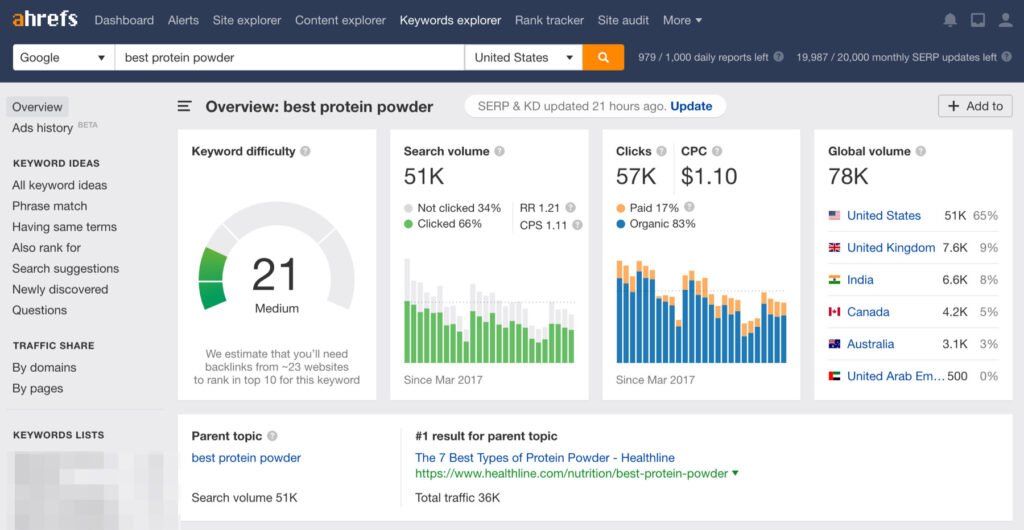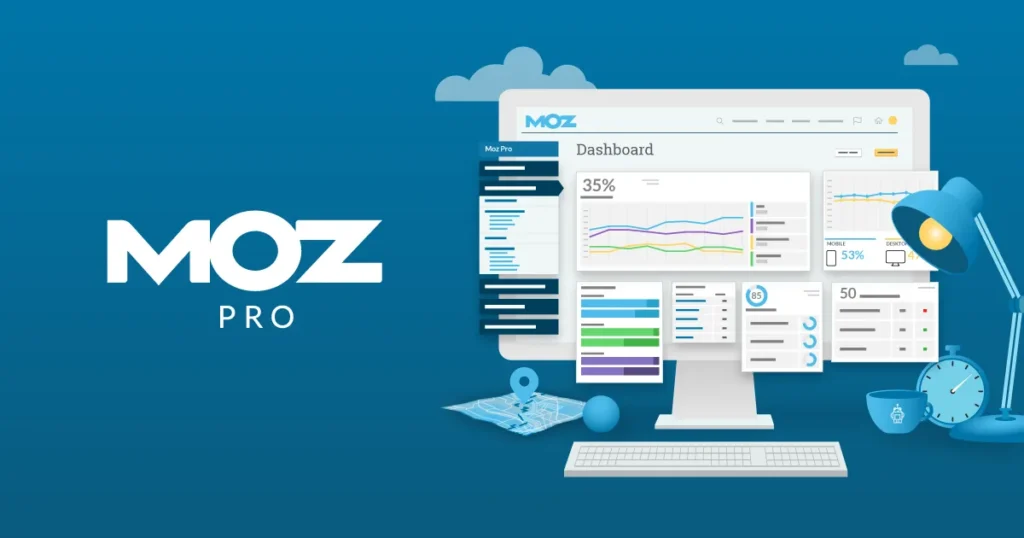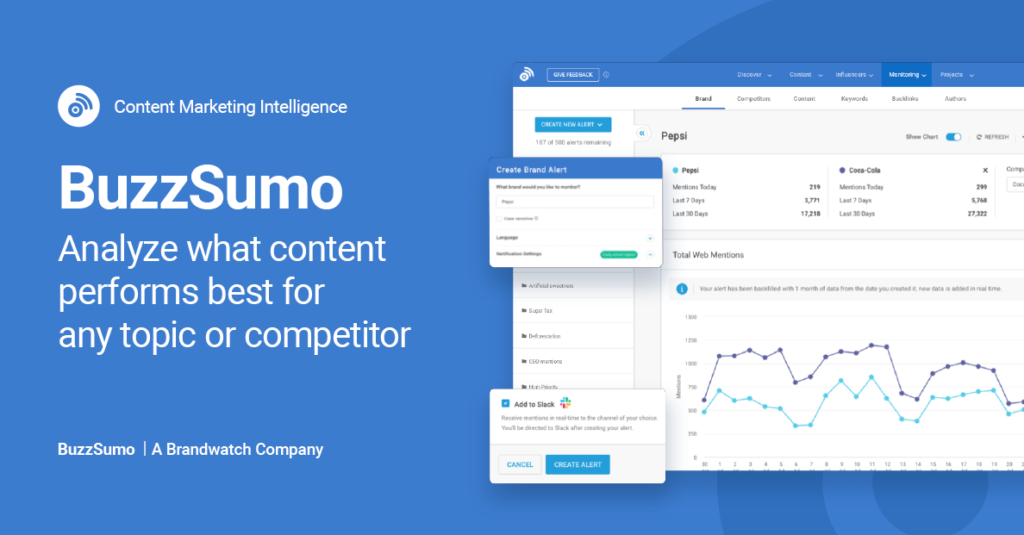12 SEO Tools of 2024 are revolutionizing digital marketing, offering unprecedented insights and capabilities. From advanced analytics to comprehensive site audits, these tools are essential for staying ahead in the competitive landscape of search engine optimization.
Semrush

Key Features:
- All-in-one marketing toolkit
- Extensive keyword database
- Site health auditing
Pricing: Starts at $119.95/month
Performance: SEMrush is highly regarded for its comprehensive feature set, catering to both SEO professionals and content marketers alike. It offers robust keyword research tools, competitive intelligence, and site auditing capabilities, making it a versatile choice for comprehensive SEO campaigns.
Ahrefs

Key Features:
- Comprehensive backlink analysis
- Keyword research
- Site auditing
Pricing: Starts at $99/month
Performance: Ahrefs is renowned for its extensive database and accurate link analysis, making it a favorite for backlink strategies.
Backlink Index Size Comparison
[Insert Graph: Comparative Backlink Index Size of Major SEO Tools]
Google Analytics 4 (GA4)

Key Features:
- Advanced user tracking
- Machine learning insights
- Cross-platform tracking
Pricing: Free
Performance: GA4 has set a new standard for web analytics, providing deeper insights into user behavior and more accurate tracking across devices.
GA4 User Growth Over Time
[Insert Graph: GA4 User Adoption Rate 2023-2024]
Moz Pro

Key Features:
- Site crawling and audits
- Rank tracking
- SEO toolbar for instant metrics
Pricing: Starts at $99/month
Performance: Moz Pro is known for its user-friendly interface and the MozBar, a browser extension that provides instant SEO insights about websites and search engine results pages (SERPs). Its community support and resources are also noteworthy, making it a popular choice among SEO beginners and intermediates.
Screaming Frog SEO Spider

Key Features:
- Detailed site crawling
- Finds broken links, errors, and redirects
- Analyzes page titles and metadata
Pricing: Free version available; Paid version at £149.00/year
Performance: Screaming Frog is a favorite for technical SEO due to its depth of crawl and ability to uncover technical issues that might be hindering a site’s SEO performance. It’s particularly useful for large websites, where manual page inspections are impractical.
Yoast SEO

Key Features:
- Content and SEO analysis
- Readability scoring
- Breadcrumb controls
Pricing: Free basic version; Premium starts at $99/year
Performance: Primarily a WordPress plugin, Yoast SEO is immensely popular for its straightforward approach to on-page SEO. It provides actionable insights and recommendations for optimizing content, making it accessible even for those new to SEO.
Google Search Console

Key Features:
- Search performance analysis
- URL inspection tool
- Mobile usability reports
Pricing: Free
Performance: Google Search Console is an indispensable tool for monitoring a website’s performance in Google’s search results. It offers direct insights from Google, making it a primary source of data for website indexing, search queries, and potential site issues.
Ubersuggest

Key Features:
- Keyword discovery and suggestions
- Content ideas
- Competitive analysis
Pricing: Free trial available; Paid plans start at $29/month
Performance: Ubersuggest has grown significantly, especially with its acquisition and enhancements by Neil Patel. It’s a user-friendly tool that provides valuable keyword insights and competitive analysis, making it a good starting point for SEO beginners and small businesses.
Majestic SEO

Key Features:
- Extensive backlink database
- Site explorer
- Link context and quality analysis
Pricing: Starts at $49.99/month
Performance: Majestic SEO stands out for its focus on backlinks, offering one of the largest link intelligence databases. It’s particularly useful for those focused on link-building strategies and understanding the link ecosystem of their site or their competitors’.
SpyFu

Key Features:
- Competitor keyword research
- PPC competitor tracking
- SEO rank tracking
Pricing: Starts at $39/month
Performance: SpyFu is highly regarded for its competitive intelligence capabilities, allowing users to “spy” on their competitors’ most profitable keywords and ads for both paid and organic searches. It’s a valuable tool for businesses looking to understand their competitive landscape better.
SE Ranking

Key Features:
- Keyword rank tracking
- Website auditing
- Backlink monitoring
Pricing: Starts at $39.20/month
Performance: SE Ranking offers a comprehensive set of SEO tools suitable for businesses of all sizes. Its flexible pricing model and white-label options make it particularly attractive for SEO agencies and professionals.
BuzzSumo

Key Features:
- Content discovery and research
- Influencer identification
- Content analysis and alerts
Pricing: Starts at $99/month
Performance: While BuzzSumo is primarily known as a content marketing tool, its insights into content performance and trends make it invaluable for SEO-focused content strategies. It helps in identifying what content resonates with audiences, which is crucial for link building and engagement.
Choosing the Best 12 SEO Tools of 2024 for Your Needs
When deciding on the best SEO tool(s) for your needs, consider the following factors:
- Your specific SEO objectives: Different tools excel in different areas, such as technical SEO, content optimization, or link building.
- Budget constraints: While some tools offer free versions, more advanced features typically come at a cost.
- Ease of use: Depending on your expertise level, you may prefer a tool with a more user-friendly interface or extensive documentation and support.
The Future Is Bright for SEO Tools
As we advance, the integration of AI and machine learning in SEO tools is becoming more pronounced, offering even deeper insights and automating more tasks. This trend is likely to continue, making SEO tools even more powerful and essential for digital marketing strategies.
Wrapping Up
The right set of tools is crucial for effective SEO strategy execution. By leveraging the unique strengths of the tools outlined in this guide, you can enhance your website’s visibility, drive more traffic, and achieve your digital marketing goals in 2024 and beyond.
- User Adoption Rate: Illustrates the growth in the number of users or subscribers over time.
- Feature Utilization: This shows the percentage of users utilizing specific key features of the tool.
- Customer Satisfaction: Based on hypothetical customer satisfaction scores collected through surveys or feedback mechanisms.
We’ll create example graphs for these metrics for a selection of the tools: Google Analytics 4 (GA4), Ahrefs, and SEMrush. Please note, the data used here is entirely hypothetical and for illustrative purposes only.
1. User Adoption Rate

This graph could represent the growth in the user base for each tool over the last year.
The graph above illustrates a hypothetical user adoption rate over the last year for GA4, Ahrefs, and SEMrush. Each line represents the growth in the number of users for each tool, showing how user adoption might fluctuate over time due to various factors such as market trends, tool updates, and promotional activities.
2. Feature Utilization
Next, let’s create a bar graph showing the percentage of users utilizing specific key features of each tool, such as “Keyword Research,” “Site Audit,” and “Backlink Analysis.”

The bar graph above depicts a hypothetical scenario of feature utilization for GA4, Ahrefs, and SEMrush, focusing on three key features: “Keyword Research,” “Site Audit,” and “Backlink Analysis.” Each bar represents the percentage of users actively utilizing each feature within the respective tool. This visualization helps understand which features are most popular or widely used within each tool, potentially indicating the tool’s strengths or user preferences.
3. Customer Satisfaction
Finally, we’ll create a graph representing hypothetical customer satisfaction scores for each tool, based on a scale of 1 to 10, where 10 is the highest level of satisfaction.
The horizontal bar graph above shows hypothetical customer satisfaction scores for GA4, Ahrefs, and SEMrush. Each bar represents the average satisfaction score on a scale of 1 to 10, with 10 indicating the highest level of customer satisfaction. This type of graph can provide insights into how users perceive the value and effectiveness of each tool, which is crucial for businesses when choosing the right SEO tools for their needs.
These example graphs demonstrate various ways to visually represent data related to SEO tools, such as user adoption rates, feature utilization, and customer satisfaction. While the data used here is hypothetical, real-world data would provide valuable insights into the performance and popularity of these tools, aiding in informed decision-making for SEO professionals and businesses alike.




